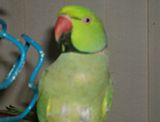one for all you smarty pants out there,
Moderator: Mods
one for all you smarty pants out there,
ok genius.
what the the little nub on the top of the tail on my babies?
i'll take a photo if i need to, but i also noticed on on amazon, and he won't let me touch it.
grab you parror and have a look at the base of the tail on the top, there will be a small black thing that looks like a new feater coming thru.
i can't find anything about them on the net.
thanks
what the the little nub on the top of the tail on my babies?
i'll take a photo if i need to, but i also noticed on on amazon, and he won't let me touch it.
grab you parror and have a look at the base of the tail on the top, there will be a small black thing that looks like a new feater coming thru.
i can't find anything about them on the net.
thanks
Adam and Dude
No need for photo!!  It is it's preening gland
It is it's preening gland
The uropygial gland, when present, lies on the mid-line dorsally on the trunk in the rump area above the levator muscles of the pygostyle. In domestic fowl, the gland is drained by a pair of ducts. Each duct drains one lobe and each duct opens into a single, narrow nipple-like papilla. Other species have up to eighteen orifices.1 There are no feathers normally on the skin over the gland. There is, however, a tuft of down feathers at the tip of the papilla in most species, and this is called the uropygial wick. In many species of bird, the tail usually flexes laterally each time the bird reaches around to contact the gland and the wick.
Among the psittacine species that do not possess a uropygial gland are the hyacinth macaw, Anodorhynchus hyacinthinus , the Lear's macaw, Anodorhynchus leari, and the Spix's macaw, Cyanopsitta spixii. All of the parrots in the genus Amazona also do not posses a uropygial gland. The gland is present in the other psittacine species. The gland is also present in canaries and most finches.
Donna
The uropygial gland, when present, lies on the mid-line dorsally on the trunk in the rump area above the levator muscles of the pygostyle. In domestic fowl, the gland is drained by a pair of ducts. Each duct drains one lobe and each duct opens into a single, narrow nipple-like papilla. Other species have up to eighteen orifices.1 There are no feathers normally on the skin over the gland. There is, however, a tuft of down feathers at the tip of the papilla in most species, and this is called the uropygial wick. In many species of bird, the tail usually flexes laterally each time the bird reaches around to contact the gland and the wick.
Among the psittacine species that do not possess a uropygial gland are the hyacinth macaw, Anodorhynchus hyacinthinus , the Lear's macaw, Anodorhynchus leari, and the Spix's macaw, Cyanopsitta spixii. All of the parrots in the genus Amazona also do not posses a uropygial gland. The gland is present in the other psittacine species. The gland is also present in canaries and most finches.
Donna
-
kyria
- Site Admin
- Posts: 3050
- Joined: Sun Sep 11, 2005 5:42 pm
- Location: Live in Australia - Have a home in Florida - Citizenship in Heaven
- Contact:
The way they rub it and pay so much attention to it you would think it was the males bits .. lol .. just the oil gland, they will bite it to release oil then madly rub it spreading the oil around their feathers during preening, clever little things 
Angie
---------
Hatred stirs up strife, But love covers all sins. {Pro 10:12}
-----------
God Bless

---------
Hatred stirs up strife, But love covers all sins. {Pro 10:12}
-----------
God Bless



